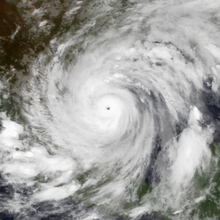
Back Huracà Alex (2010) Catalan Huracán Alex (2010) Spanish Hurrikaani Alex (2010) Finnish Ouragan Alex (2010) French Hurikan Alex (2010) Malay Orkanen Alex NB Horcan Alex PAP Huragan Alex Polish Алекс (ураган, 2010) Russian Hurricane Alex (2010) SIMPLE
 Alex making landfall in Mexico at peak intensity on July 1 | |
| Meteorological history | |
|---|---|
| Formed | June 25, 2010 |
| Post-tropical | July 2, 2010 |
| Dissipated | July 6, 2010 |
| Category 2 hurricane | |
| 1-minute sustained (SSHWS/NWS) | |
| Highest winds | 110 mph (175 km/h) |
| Lowest pressure | 946 mbar (hPa); 27.94 inHg |
| Overall effects | |
| Fatalities | 51 |
| Missing | 22 |
| Damage | $1.52 billion (2010 USD) |
| Areas affected | Greater Antilles, Central America, Yucatán Peninsula, Northern Mexico, Texas |
| IBTrACS / [1] | |
Part of the 2010 Atlantic hurricane season | |
Hurricane Alex was the first tropical cyclone of the 2010 Atlantic hurricane season, and a rare June Atlantic hurricane. Originating from an area of disturbed weather on June 25, 2010, it slowly developed in the western Caribbean Sea and struck Belize as a strong tropical storm. After entering the Gulf of Mexico, Alex became very large and encountered conditions favorable for gradual development. Early on June 30, the cyclone attained hurricane status as it approached northeastern Mexico, the first June hurricane in the Atlantic basin since Hurricane Allison in 1995, and the storm rapidly intensified just off the coast of Tamaulipas. Alex made landfall near Soto la Marina as a Category 2 hurricane on the Saffir-Simpson Hurricane Wind Scale. Alex rapidly weakened after landfall, with the storm losing its tropical status on July 2, before fully dissipating on July 6.[1]
Alex caused the deaths of at least 51 people along its path, and produced over $1.5 billion (2010 USD) in damage. The precursor of the hurricane produced substantial rainfall across the Greater Antilles, causing one death in the Dominican Republic. Fourteen people were killed in Central America as a result of flooding during the first landfall of Alex. In Mexico, the storm's outer rainbands killed three people in Acapulco, one person in Oaxaca, and another in Chiapas. At its final landfall, Alex caused at least fifteen deaths in Nuevo León, eight in Coahuila, six in Guanajuato, and one in both Tamaulipas and San Luis Potosí; an additional twenty persons were reported missing.
Alex triggered widespread power outages throughout northeastern Mexico and southern Texas. Damage was most evident in the Monterrey metropolitan area, which faced what Nuevo León governor Rodrigo Medina de la Cruz described as, "the worst weather phenomenon in its history."[2] Following Alex's final landfall, a state of emergency was declared for most of Nuevo León, portions of Tamaulipas, and Texas. Widespread flooding from the storm affected 500,000 people throughout northeast Mexico, and ruined over 200,000 hectares (500,000 acres) of crops in the region, equivalent to 11% of the region's total farmland. Despite the significant damage and death toll, the name Alex was not retired following the season.
© MMXXIII Rich X Search. We shall prevail. All rights reserved. Rich X Search